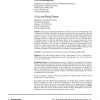Free Online Productivity Tools
i2Speak
i2Symbol
i2OCR
iTex2Img
iWeb2Print
iWeb2Shot
i2Type
iPdf2Split
iPdf2Merge
i2Bopomofo
i2Arabic
i2Style
i2Image
i2PDF
iLatex2Rtf
Sci2ools
IJSNET
2008
2008
Event-driven sensor deployment using self-organizing maps
: Coverage is an important optimization objective in pre and post-deployment stage of a Wireless Sensor Network (WSN). In this paper, we address the issue of placing a finite set of sensors to cover an area of arbitrary geometry. Unlike many existing works concerned with uniform coverage of a target area, we take into account the realistic consideration of the probability density for events to be sensed, termed as event-driven coverage. The objective is to distribute sensors so that the distribution density of the sensors matches that of the probability density of events to be sensed. The expected event distribution is assumed to be stationary and known a priori, directly or indirectly, in the form of sample maps. In this context we explore and evaluate the concept of Self-Organizing Maps (SOMs) and its derivative variants to address the coverage problem. Various forms of SOMs methods as well as the known methods of Virtual Fields are also compared via experimentation.
| Added | 12 Dec 2010 |
| Updated | 12 Dec 2010 |
| Type | Journal |
| Year | 2008 |
| Where | IJSNET |
| Authors | Cris Koutsougeras, Yi Liu, Rong Zheng |
Comments (0)

